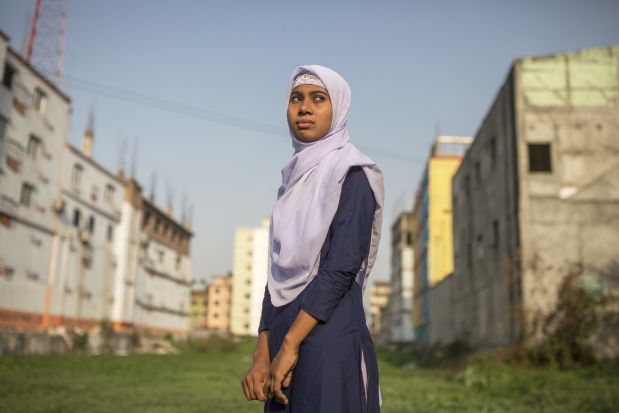Five Years After the Disaster: Rana Plaza Victims Still Hurting

DHAKA, Apr 24 (IPS) - Asma saw the roof collapse over her colleagues. Johora was dragged out of the rubble by her hair. Shirin was only 13 years old when her eyes and airways were filled with concrete dust. Five years have passed since the Rana Plaza garment factory in Bangladesh collapsed, killing 1 134 people.BANGLADESH. Garment factories lie side by side along the freeway leading into the capital, Dhaka. But between the concrete blocks, a square, uninhabited piece of land is overgrown with greenery. This is where Rana Plaza used to be. Shirin Akhter, 18, turns her eyes away.
"I don't feel good about being here," she says.
Five years have passed since the factory collapsed in what became the most deadly industrial accident in modern times.
Shirin was only 13 but had already worked in the garment industry for two years.
"I was very young. When visitors came to the factory, I had to hide in a storeroom. But there were other girls there who were even younger," she says.
The memories are still fresh. The muffled sound of the roof caving in. The concrete dust that filled eyes and lungs. The horror when discovering that the exit was blocked by rubble.
"We were huddled together in the stairwell, many cried and were scared. One person had broken their skull bone. When I saw the pouring blood, I started crying too," says Shirin Akhter.
On the morning of April 24, rumours were swirling. The day before, large cracks had been discovered in the eight-storey Rana Plaza and the 5 000 garment workers who worked in it had been evacuated.
"Nobody wanted to go in, but the management said we would lose our jobs if we didn't," says Johora Khatun, 22.
Asma Begum, 28, walked up the stairs up to the factory's third floor. For just under an hour, she and her colleagues sat by powerless sewing machines.
"Then they started the generator. Five minutes later, the building collapsed. I think it was the vibrations that did it."
At 08.57am, the top floor collapsed. Asma Begum began running towards the exit as soon as she heard the sound. Shortly after, sha saw the ceiling coming down on top of her colleagues.
"I was sitting by the stairwell. But there were 1 000 people on my floor and not everyone made it out."
Johora Khatun worked on the same floor, but further into the room.
"I started running but fell after a few metres."
She was saved by a sewing table. Johora Khatun avoided being crushed but found herself stuck under concrete and rubbish.
"For the first few hours, I thought I might survive, but then I lost hope.
When rescue workers finally arrived, they could not reach Johora's arms and had to pull her out of the rubble by her hair.
The search for survivors continued for weeks. The final death toll was recorded as 1 134. Another 2 500 were injured.
The Bangladesh garment industry had claimed fatalities before, but Rana Plaza put the working conditions in the international spotlight. The disaster was too big to ignore.
Just a few weeks later, the Accord on Fire and Building Safety in Bangladesh came into force. As a part of the five-year deal, about 200 international fashion companies committed to fund workplace improvements at their subcontractors.
"Thousands of things have been repaired and fixed. It has definitely contributed to a safer working environment," says Petra Brännmark, communications manager at the global labour union IndustriAll, which was a key driver of deal negotiations.
The Accord ends in May. As of yet, 144 fashion companies have signed a five-year extension. The number of final signatories will give an indication of how highly the international buyers value the safety of the garment workers, now that the media has turned it's spotlight off.
"Not all those who signed the first accord have signed the second one yet," remarks Petra Brännmark.
The perception that the accord has been a success is shared by workers' organisations in Bangladesh. Babul Akhter is the chairman of the trade union organisation BGIWF, which organizes 29,000 garment workers:
"Rana Plaza attracted the attention of the world and opened a small window for us. Much has changed. The working environment is better, and all factories have fire protection equipment now."
But the price was high. It was paid by those who died. By those who lost their relatives. And by those who survived — but for whom life never became the same again.
One year after Rana Plaza, Shirin Akhter once again took up employment at a garment factory, but only managed five days before the panic attacks became too strong.
Without income, she is regarded as an economic burden for the family and her stepfather has decided she needs to get married.
"I would like to study," she says. But my stepfather is the family's only breadwinner. He decides."
This story was originally published by Arbetet Global
© Inter Press Service (2018) — All Rights Reserved. Original source: Inter Press Service
 Global Issues
Global Issues